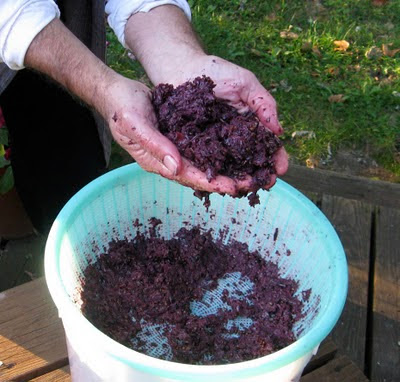 Yield skyrockets; learning curve remains gradual
Yield skyrockets; learning curve remains gradualThe technique I used to preserve grapes through the summer worked too well. In the end, the grapes turned overripe and began to fall off the vine. This outcome is not entirely bad, though.
I managed to extend the season for my young St. Vincent grapevines by shielding them from pests with a gauzy fabric —
We had no losses whatsoever from Japanese beetles, and I did not have to harvest early to preserve the yield from grape-munching birds.
In the deluges of the first half of September, at least 10 inches of rainfall soaked the vineyard, keeping sugar levels low. Throughout late September, Brix levels remained at 15-17. I held out, hoping for 22-23, corresponding to the typical wine alcohol content of roughly 12 percent. Assuming I could stand pat until I ran up against the danger of frost, I allowed plump, heavy clusters grapes to remain on the vines into October.
However, on Sunday, Oct. 3, I encountered an unexpected loss: a few clusters had fallen off the vines and gone splat on the earth below. I learned from my viticulture mentors that this behavior is typical of St. Vincent grapes, which do not necessarily reach optimum sugar levels before they become overripe.
I harvested and processed the grapes immediately.

Grapes: 14 pounds
Brix: 17
Sugar added: about 2 cups
Corrected Brix: 24
Wine: 4 liters (including probably 1 liter of yeasty sludge)
These results, while puny, represent an exponential spike from last year's yield of a total of 74 grapes. Yes, we counted them (It was easy).
Next year, I will set more modest expectations for sugar values and be ready to harvest before fall-off-the-vine syndrome kicks in.
3L wine + 1L sludge.
This year, three of our plants produced grapes. Next year, three more will begin producing. Another two plants are in their first year. So, we're still at least two years away from a potential yield that will allow us to make a 19-liter-carboy batch of wine. The quest continues.



5 comments:
Very nice....can't wait to sample some day.
What a joy to grow, harvest and create your own wine. Congrats on a job well done!
Bravo! How easy it would have been, after last year's pitiful harvest, to have succumbed to ennui and despair, an existential acknowledgement of the difficulties in growing grapes. Really, when you consider the challenges, it's a sort of wonder that we haven't all starved to death. Growing plants that produce food is not a particularly easy process, unless you want to live on zucchini.
Your continuing perseverance, besides being entertaining (the Sisyphus of grape-growing), is enobling. I suppose that sounds overwrought, but I do think that to continue to learn, adapt, and to slowly build a home vineyard is a genuinely cool thing. This is really neat, Ed, and it's a privilege to be allowed to watch from afar.
I hope the wine turns out!
Very cool. I hope I get to taste it someday (I don't think I'll ever have the patience to make wine--you can drink beer in three weeks). And you can always chaptalize--if it's good enough for Lafite, it should be good enough for you...
Chaptalize? Can't you just say "add sugar"? That's what I did. I was just hoping that I wouldn't have to. In any case, it's good to hear from you. — Ed
Post a Comment